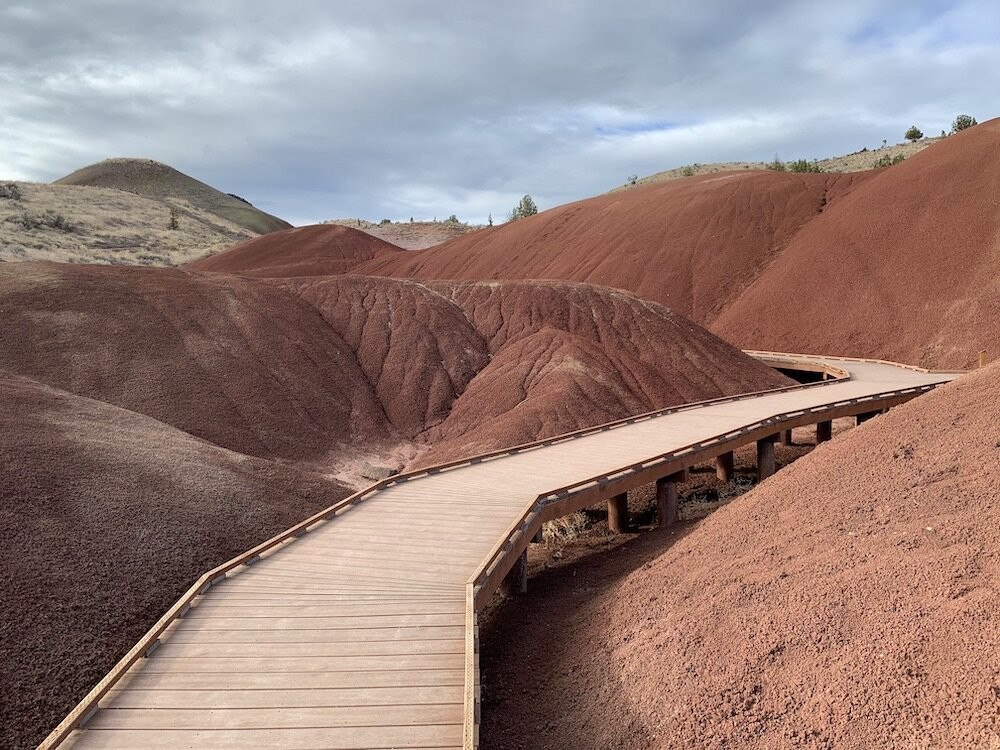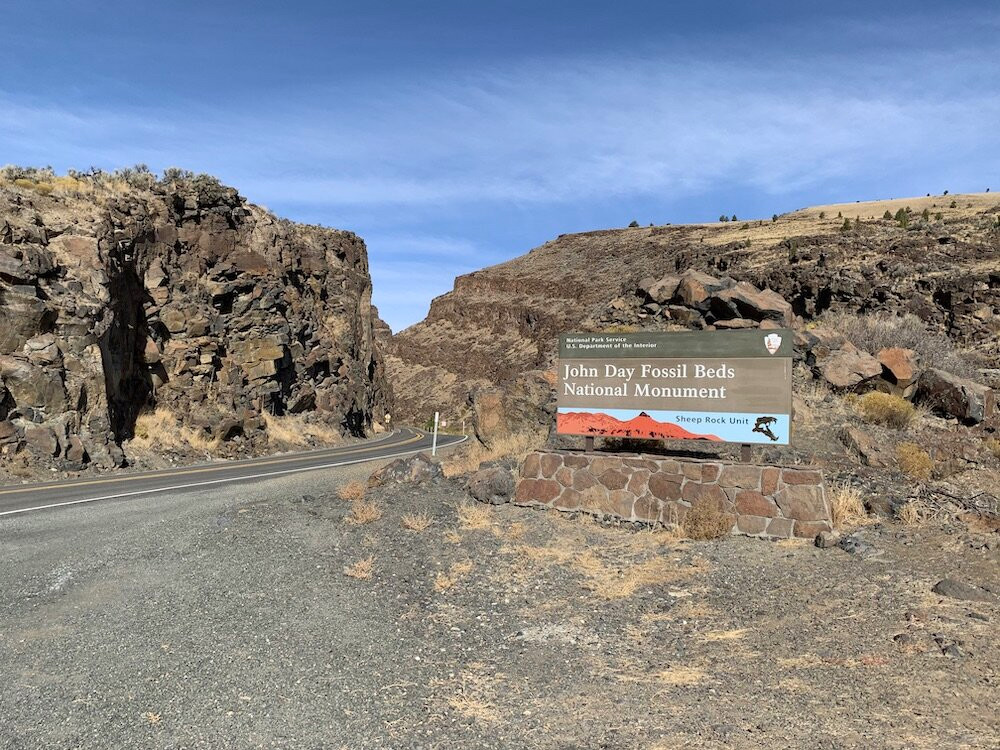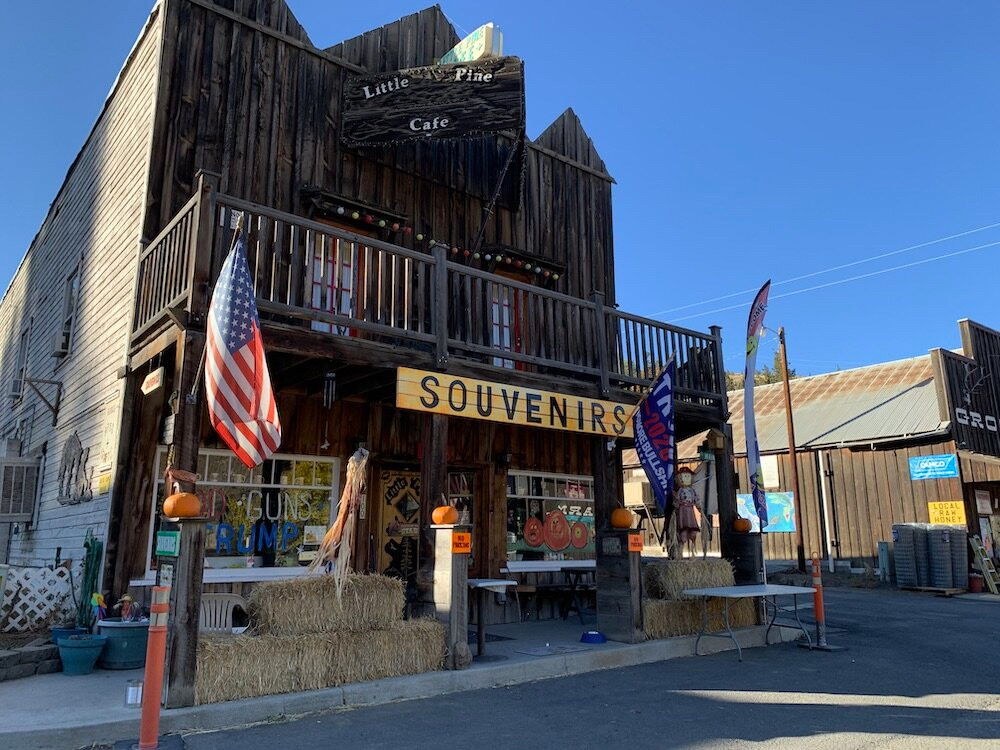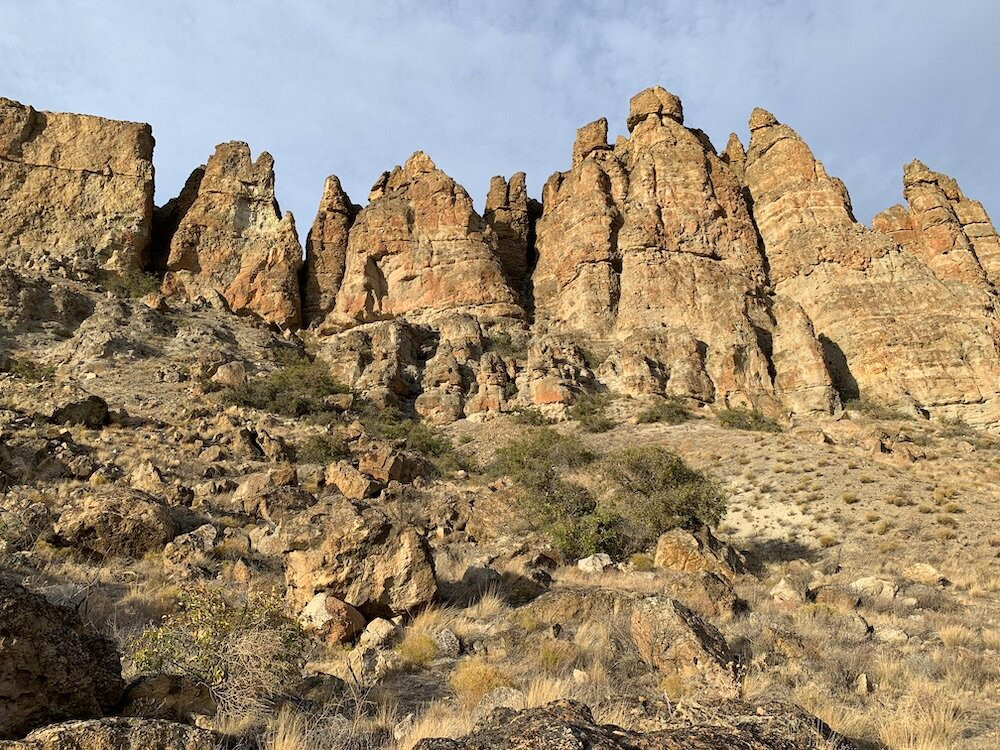
JULIA DUIN, of Religion Unplugged, visits the Thomas Condon Paleontology Center in Oregon…
Mitchell, Oregon, US
Religion Unplugged
Prehistoric Oregon once was a lush refuge for a zoo’s worth of exotic animals, tropical fruits, palm trees and a climate much like present-day Panama. Fifty-five million years ago, avocados and bananas were plentiful and their remains – along that of the animals – were scattered around the central part of the state.
Today, the area is high desert and a fossil playground. North America has some of the richest troves of fossils in the world, but most of the sites include fossils laid down within a time span of only a few million years. Oregon outdoes them all. It is the only place in the world where 50 million years of continuous evolution of ancient mammals and flowering plants are preserved in one place.
And a humble Congregationalist minister, with a Bible in one hand and a geologist’s pick in another, was at the centre of discovering this. He is Thomas Condon, the only clergyman with a national park visitor centre named after him and a man who understood early on how religion and science could fit together.

Sensitive soils in the rust-colored hills are protected by a boardwalk on the Painted Cove Trail. PICTURE: Julia Duin.
If you drive to the John Day Fossil Beds National Monument in eastern Oregon, smack in the middle is the Thomas Condon Paleontology Center, a $US7.6 million museum and visitor centre finished in 2005. There is very little information about Condon himself at the centre, but it is possible to poke about Condon’s former haunts in The Dalles, a spot some 236 kilometres to the north on the Columbia River, to find out more about this amazing man.
What inspired this minister to attempt a rapprochement between evolution and faith at a time when neither side was talking to each other?
“What inspired this minister to attempt a rapprochement between evolution and faith at a time when neither side was talking to each other?”
During the 1860s, The Dalles was a prominent commerce centre. Thousands of people swarmed into the area to seek their fortune and right in the middle of it all in 1862, Thomas Condon arrived with his wife, Cornelia.
Condon’s interest in geology had begun in Ireland, where he was born in 1822 as the son of a stonecutter. When he was 11, the family emigrated to New York. He began gathering fossils in upstate New York and devoured what literature there was on at the time as to their origin. He decided to go into the ministry, attended Auburn Seminary, but could not get parish work because of anti-Irish sentiment.
In 1852 at the age of 30, he became a home missionary (one of the few ministry positions open to him), in the Oregon territory, which at the time included land from the Pacific Ocean to the Rocky Mountains plus British Columbia. When he and Cornelia sailed around the horn of South America to get there, he brought along his fossil collection.
At this point of the 19th century, fossil collecting was quite the rage, as universities on the Eastern Seaboard were assembling a geologic history of this relatively new (to them) continent and were commissioning trips across the Midwest to research fossil-rich troves such as the Dakota Formation in central Kansas and dinosaur remains in the Judith River Basin in central Montana. They were discovering that the entire state of Nebraska was one huge fossil graveyard. Paleontologists such as Othniel Marsh of Yale University and Edward Drinker Cope of Drexel University in Philadelphia were willing to pay for fossils in this virgin territory, and collectors knew this.
Gathering fossils, however, was not easy. Conditions in the remote areas where fossils lay were primitive at best, and Kansas in particular was known for extreme weather. Plus, local Indian tribes were very much on the warpath during the post-Civil War era when the West was quickly expanding, obligating fossil hunters to take along military escorts. Oregon was one such place.
Before moving to The Dalles, the Condons arrived in western Oregon in 1853, trying to establish churches in small towns like St Helens, which is on the Columbia River northwest of Portland, and in Forest Grove and Albany, which are cities to the south in the fertile Willamette Valley.
Failing to gather a congregation in any of these places, the Condons struck out for The Dalles in March 1862. It was a boom town, incorporated in 1857, and a centre for gold diggers. Native Americans had lived in The Dalles for 10,000 years, making it one of the oldest inhabited sites in the Western Hemisphere, but they’d never mined the gold.

Oregon Highway 26 winds through the dramatic basalt cliffs of Picture Gorge along the John Day River. PICTURE: Julia Duin.
It was a bar town as well. Condon started his congregation, which was simply called First Congregational Church, with eight members. There was no building, so he preached inside the (at the time fairly new) Wasco County courthouse, which had been built in 1859, the same year Oregon became a state. The county covered all of eastern Oregon and four other states, including parts of what would be Yellowstone National Park.
But the courthouse had its issues, one of them being the presence of the jail cells on a lower floor and the prisoners who inhabited those cells. Bed bugs and lice found their way from the jail to the upper floors of the courthouse; moreover, the prisoners would sing along to the hymns, but add their own bawdy lyrics.
Because Condon was one of the few educated people in town, the church began to grow and within six months, he’d raised $US1,000 for a building on Third Street. By 1868, it had 46 members; by 1871, just before Condon left, it had 61. But those were official members; the average Sunday attendance was much higher, as there were 214 children enrolled in Sunday school alone.
“He was well known around town,” says Karl Vercouteren, the retired minister of the 160-year-old church, now called United Church of Christ, Congregational. “He wasn’t getting a very good salary, so at one point, some of the gamblers took pity on him and presented him with a big fancy gambler’s coat with big pockets and fancy fur. He thanked them for the coat and said he could make the coat behave.”
Life got slowly better. Condon’s brother, James, followed him to Oregon and became a postmaster in what became the town of Condon, Oregon.
Thomas Condon would wander on the bluffs above town and visit Fort Dalles, home to a volunteer calvary. There were lots of soldiers patrolling about and Condon managed to interest its commander, John Drake, in rocks as well. Drake let the minister know that, while his men were patrolling about the John Day River south of The Dalles in 1864, they found fossils.
In 1865, Condon headed south with a military party. The red, green and white-striped rocks were like nothing he’d ever seen before and his first fossil, found in an area known as the Blue Basin, was that of a turtle. It was clear that the region had once been a lush sub-tropical area with citrus trees and coffee plants. Condon found mammal fossils – oreodonts – early camels – and fossils of early horses, at the time about the size of a large dog.
At the time, the Christian intellectual world was in some ferment, being that Charles Darwin’s Origin of the Species had come out in 1859, upsetting the then widely held view from Genesis in the Bible that the world had been created in six days. The possibility that millions of years were in play didn’t ruffle Condon, who saw the six days as large historic epochs rather than literal days. German higher criticism, a method of study that more often than not considered the Bible as historically unreliable, was in full flower by the mid-19th century, making Condon’s fossil discoveries all the more threatening.
“Evolution was simply God’s method of working and thus not atheistic or infidel,” Condon was known to say. “The church has nothing to fear from the uncovering of the truth.”
Fossils, he believed, were evidence of the presence of God, ordering creation over vast stretches of time.
“I once believed God created a small fact,” he said. “I now see He must have created a whole system of facts at once.” He came up with “development theory,” a theistic account with how the Earth could have evolved under the watchful eye of God.

The Little Pine Lodge and Souvenir Shop sits on Main Street in Mitchell, Ore, and sells everything from guns to goat milk soap. PICTURE: Julia Duin.
Anxious to share his finds, Condon sent fossil samples to scholars on the East Coast and invited Marsh, the Yale professor, on a fossil-hunting expedition. Marsh’s subsequent paper on the history of the horse – along with a missing link in horse evolution found among the fossil beds – didn’t credit Condon. Moreover, Marsh never returned certain specimens that Condon loaned him.
Condon was better accepted by his fellow residents, who were very taken with his lectures. When a fire swept the town, neighbors came and saved his fossils and furniture from the flames.
Meanwhile, his oldest son, Eddie, had become his father’s protégé and was accompanying him on fossil-hunting trips. Condon could see, from his son’s inquiring mind, how important it was for religious teachers to guide young minds through the conflicting opinions and theological minefields of the day. Then in February 1871, 18-year-old Eddie died of pneumonia. His death shook Condon to the core.
Condon began casting about for a change in venue. Vercouteren says that when the famed suffragette Susan B Anthony visited towns along the Columbia River Gorge that same year, she met Condon on her return trip on a steamer back to Portland. Maybe Condon was using that trip to the west to scope out other opportunities, for in 1872, he resigned his mission post and returned to western Oregon to accept a professorship teaching geology at Pacific University in Forest Grove. By then, Oregon had become a state and was looking to build a state university in Eugene, a pleasant, hilly locale 106 kilometres south of Salem, the state’s capital.
Condon also founded First Congregational Church in Eugene and died in 1907. Condon Hall, constructed in 1925 at the University of Oregon, is named after him. His fossils are housed at the university’s Museum of Natural and Cultural History.
Easily the best educated man in Oregon, Condon was hired as the state geologist. He moved to the new University of Oregon in Eugene in 1876 and taught the sciences there for 30 years. He used his fossils to teach his students and in 1892, he published a geological history of Oregon. When the first class of five students graduated in 1878, the valedictorian was the only female in the class – and Condon’s daughter, Nellie.
Condon realised how the students who studied the sciences had no Christian teacher to interpret how evolution could fit into what the Bible taught. The church, he decided, had to be defended by scientists. Theologians were not up to the new challenges of the day.
Condon also founded First Congregational Church in Eugene and died in 1907. Condon Hall, constructed in 1925 at the University of Oregon, is named after him. His fossils are housed at the university’s Museum of Natural and Cultural History.
Today, the fossil beds that Condon made famous are scattered across 14,000 acres in the John Day Fossil Beds National Monument, a five-hour drive east of Portland. Spread out on three sites amidst high country sagebrush, juniper and rabbitbrush bushes, it is an expansive park with multiple trails, explanatory signs and the visitor centre (named after Condon) with a working fossil lab.
It takes at least two days to thoroughly visit the sites, known as the Clarno, Sheep Rock and Painted Hills Units, each of which has walking trails and explanations of what kinds of fossils were found nearby. They are near places like the Picture Gorge, a set of immense black and reddish-brown rock walls of ancient lava that tower more than 3,000 feet above Oregon Highway 26.
The Painted Hills are a section of the fossil beds that is a palette of red, yellow and black-striped hills formed over a 33-million-year period. The red layers were rusted and oxidised rock; the yellow layers are weathered volcanic ash, and the black bands are petrified plant material; somewhat like low-grade coal. Nearby, you can walk past rust-red sand dune-shaped hills that contain prehistoric fossils.
Elsewhere, there are brown-layered rock basalts in a landscape tilted at odd angles to show immense geologic forces at work. The area was buried in volcanic lava every few thousand years or so, resulting in places like Cathedral Rock, a cliff that sports a bright green celadonite clay band against the surrounding sand- and red-hued bands. It’s understandable how stunning this area must have appeared to early explorers.

The Clarno unit palisades are 150 feet high and were formed 48 million years ago when huge mudflows swept through Oregon. PICTURE: Julia Duin.
If you want to see where Condon spent 10 years of his life, take a walking tour of The Dalles where there’s two landmarks representing Condon’s life. His original home at 512 Union Street is long gone, but there is a small display about Condon’s life is on the second floor of the original historic courthouse at 410 W. Second Place. (Don’t get that one confused with two other courthouses, built in 1882 and 1915, in town as well.)
The church, at 111 E Fifth Street, is not the original building that Condon knew (it burned down) but the present structure has a stained glass window showing the original courthouse and original church building on Third Street. There is a history room (one has to make an appointment to get in) that has Condon’s original pen and some of his correspondence dating back to his era.
The bulk of visitors to The Dalles are tourists who sail up the Columbia on trips organised by the American Express Cruise Line, according to local historian Sandy Bisset.
“Most of these folks have never heard of him,” she says of Condon, “but he’s big in this area because he was our first state geologist.”
According to the 1928 book Thomas Condon: Pioneer Geologist of Oregon, written by another Condon daughter: Ellen Condon McCornack, her father was much more than just a historic state official. He was someone who was able to make the theory of evolution a story about a wider conception of God.
“It involved a plan of unthinkable grandeur, beginning with the smallest, simplest things, gradually unfolding into more complex life, often interrupted by some great upturning of nature,” she wrote, “but never losing the continuity of purpose, the steady progress toward the culminating glory of all: the spiritual life of man.”
Julia Duin is a veteran journalist who has worked as an editor or reporter for five newspapers, has published six books and has master’s degrees in journalism and religion. She currently freelances out of Seattle for the Seattle Times, Washington Post and other outlets.





